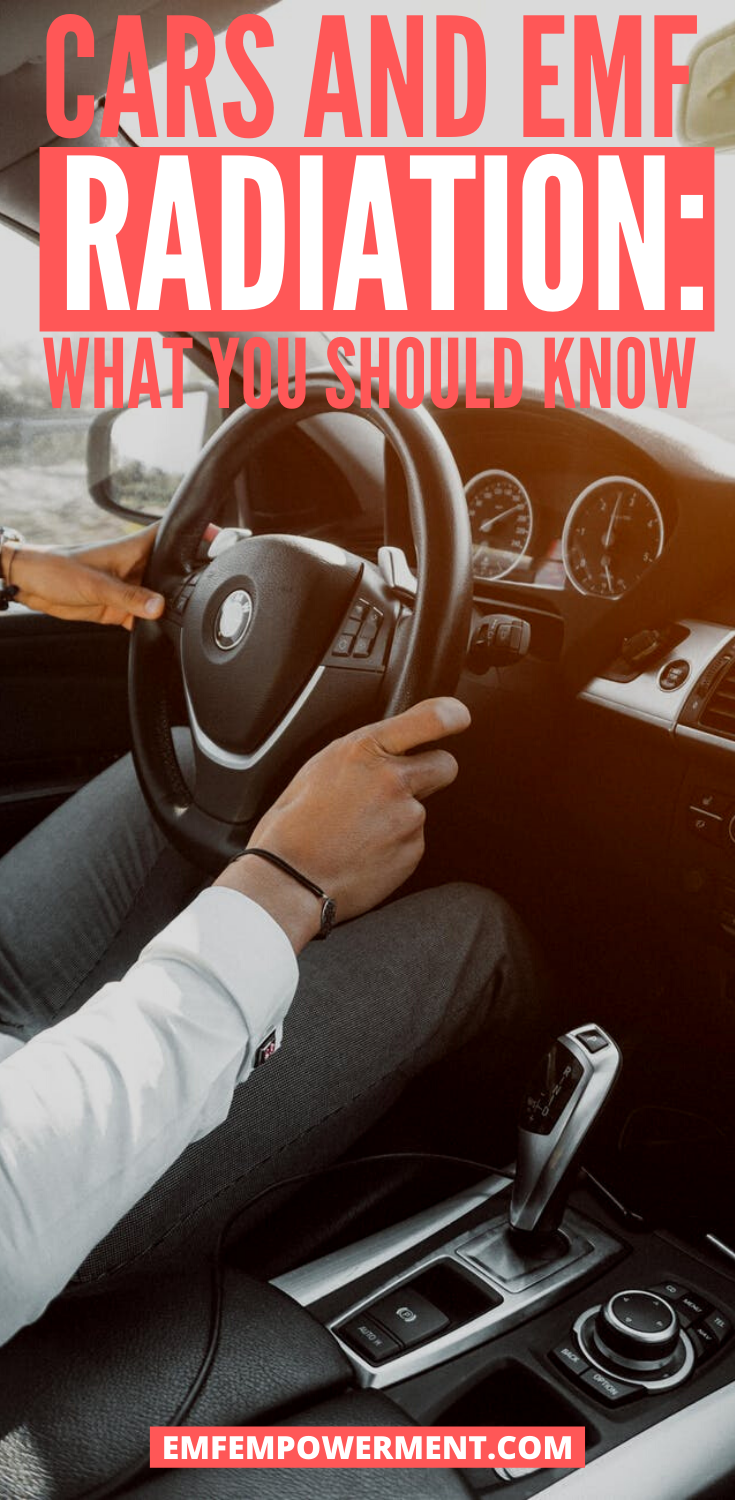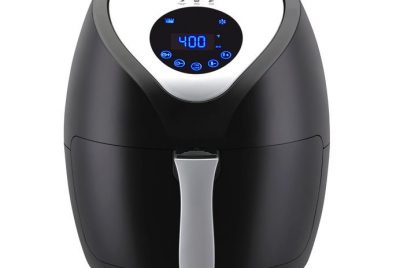On April 3, 1973, the first mobile phone was created. Since then, cell phone technology has…
EMF Car Protection: A Complete Guide

*We may earn a commission for purchases made using our links. Please see our disclosure to learn more.
In the morning, you hop in the car on the way to work. Or maybe you load the kids into the SUV before school. Whether you drive a car, an SUV, a truck, a minivan, or something else, automobiles have become a central part of life for many Americans — particularly those living in areas away from public transportation. Cars afford us a great deal of freedom, and many of us can’t imagine life without one.
And while cars are an important part of the daily routine for many, it turns out they may also be bad for our health. Cars produce EMF radiation, which has been tied to glioma, male infertility, heart tumors, and a number of other health concerns. Some sensitive individuals even experience unpleasant symptoms such as nausea, irritability, itchiness, and depression when exposed to high levels of EMF radiation.
To learn more about what you can do to protect yourself from EMF radiation in your car, read on.
Cars and EMF radiation
There are several ways in which cars produce EMF radiation. Relay switches in the vehicle’s engine produce magnetic field radiation, a form of extremely low frequency (ELF) EMF radiation that has been tied by research to childhood leukemia and other health problems. The car’s alternator and battery generate dirty electricity, which flows through the car’s wiring while the vehicle is turned on.
Interior computers and other electronics produce RF-EMF radiation that becomes trapped in the engine compartment, forming a sort of Farraday cage that the vehicle’s inhabitants are inside. This is obviously quite problematic, as it exposes the car’s passengers to EMF radiation for the entire time the vehicle is turned on. Modern, feature-rich cars produce the highest amount of RF-EMF radiation. RF-EMF has been tied to brain and heart tumors, male infertility, miscarriages, and is regarded by the International Association for Research on Cancer as possibly carcinogenic.
High EMF producers
Hybrid vehicles produce the highest amount of EMF radiation. This is due, in large part, to the batteries that these vehicles use for power. The batteries in all vehicles produce dirty electricity, and the batteries in electric cars are no exception. In fact, they produce a great deal more because they are so much more powerful.
Modern, fully-loaded vehicles are also high producers of EMF radiation. Features such as remote start, keyless entry, and keyless ignitions all result in the production of RF-EMF radiation. Many of the features that make these cars so convenient are, in fact, creating more radiation.
Electric cars also generate a great deal of EMF radiation as many of them rely on powerful lithium ion batteries, very similar to a hybrid vehicle. The primary difference is that hybrids switch over to gasoline operation– with an electric, the battery really is the main power source for the vehicle. Some of the additional bells and whistles featured in electric cars contribute to their EMF production, as well. Many models of Teslas, for example, offer on-board WiFi, Bluetooth, keyless operations, and auto-pilot mode — all of which create additional RF-EMF radiation.
Low EMF producers
The lowest producers of EMF radiation are standard, gas vehicles with minimal features. While they may not be exciting, cars that come without modern features produce significantly less EMF radiation. These days, however, it’s easier to purchase an older car than it is to find a new car without modern amenities.
In 2010, Consumer Reports did a test on various 2008 model vehicles to compare the level of EMF radiation produced. The Chevrolet Cobalt produced the highest amount of EMF radiation out of all vehicles tested, at 30mG. Most other vehicles were under 5mG, with the exception of the Chevrolet Tahoe Hybrid, which came in at 14mG. As cars have changed over the years, however, it’s highly likely that modern cars produce a great deal more of EMF radiation because of all the extra technology-rich features.
Testing your vehicle
If you’re curious how much EMF radiation your car produces, you can use an EMF meter to check. For those who don’t currently have an EMF meter, one great option is the TriField TF2, which can detect electric, magnetic, and RF radiation. This is important because cars produce both ELF and RF-EMF radiation, so you really do want an EMF meter that can detect both. The durability, accuracy, and reliability of the TF2 help make the investment well worth it.
To test your car’s EMF levels, you’ll need to take a few different readings with the meter positioned in different areas throughout the vehicle. The amount of EMF present will likely vary depending on what features of your vehicle you’re using, so you may need to take multiple measurements at each location. You may want to record the readings as you go so you can refer back to them later.
Try to measure the EMF levels in the driver seat, passenger seat, and each seat in the back. Additionally, take measurements by the head area, the torso, and the legs. Do this once with the car off to determine a level of comparison. Repeat the process with the vehicle on and all accessories off to determine how much EMF radiation the engine is producing. Next, turn one accessory (such as the air conditioning) on and repeat the process again. Turn that accessory off, switch another one off, and repeat. Do this until you’ve measured the levels of each accessory in the vehicle.
This is a time-consuming process, but it allows you to narrow in on what accessories are producing the highest amount of radiation. This will allow you to better lower your exposure to EMF radiation. Avoid turning on the accessories that produced the highest amounts of EMF radiation if at all possible.
EMF car protection tips
If you spend a lot of time in your vehicle, there are things you can do to lower your exposure to EMF radiation. You can’t eliminate it entirely, but the following steps could help reduce your risk of suffering from EMF related illnesses. These steps also may be helpful if you suffer from EMF sensitivity.
1. Only turn on what you need
As the test above probably revealed for you, the accessories in your car can create a great deal of EMF radiation. If you’re trying to reduce your levels when you’re behind the wheel, only turn on the electronics and gadgets that you need. If you can live without the radio, turn it off. If the temperature is comfortable, don’t use air conditioning or heating. Turn off any unnecessary bells and whistles such as seatback DVD players, and understand that while they are in use, they are producing EMF radiation.
Keeping your accessory usage to a minimum will go a long way toward lowering the amount of EMF radiation generated by your car. The radiation produced by the engine is somewhat unavoidable, but the radiation produced by accessories is something you can control. Only turn on what you need, and shut off what you don’t.
2. Opt for a vehicle with fewer accessories
With tip number one in mind, when you’re in the market for a new car, try to pick the one that isn’t loaded. Cars without all the extras don’t produce as much EMF radiation as vehicles with DVD players, interior computers, heated seats, color-changing interior lights, USB ports, and other features that don’t really impact the performance of the automobile. Not only will you be exposed to less EMF radiation by not having those features, but you’ll likely save a sizeable chunk of money on the vehicle’s price tag.
3. Wear EMF protective clothing
If you spend a lot of time in the car commuting or traveling, consider investing in a car outfit. At the very least, an EMF protective hoodie could shield your torso and arms from EMF radiation. BlocWave makes a Protective Hoodie that shields against 99% of EMF radiation. The hoodie will break down over time, but you can extend the life by only wearing it while in the car. Other types of EMF protective clothing include beanies, boxer briefs, tank tops, undershirts, and women’s panties. They may not cover as much surface area as a hoodie, but any protection is better than none.
4. Turn off Bluetooth if possible
Many modern cars come with built-in Bluetooth so you can connect your phone and other devices. While this feature can be pretty convenient, Bluetooth also produces a large amount of RF-EMF radiation. Not all cars allow you to shut off the Bluetooth receivers, but if yours does, consider switching them off. Most of the time, the Bluetooth on and off settings can be found on your car’s touchscreen computer. If all else fails, consult your car’s user manual or do an Internet search for how to turn off Bluetooth for your car. Be sure to include the vehicle’s year, make, and model in your search phrase for best results.
5. Keep only the back speakers on
For many people, music and driving go hand-in-hand. Or maybe you prefer talk radio or audiobooks. Whatever you choose to listen to, there’s a good chance you listen to something. Instead of blasting all of your car’s speakers, however, consider switching off your front speakers and only keeping the back ones on. If you have children in the backseat, you may want to do the opposite — keep the speakers on upfront, and off in the back. This is because speakers produce EMF radiation, so shutting off as many as you can will lower the amount of radiation produced.
6. Store your phone away from you
When you’re in the car, it can be difficult to put distance between you and your phone. If you’re going to be in the vehicle for an extended period of time, however, you should probably store your phone as far away from you as you possibly can. If that’s not feasible, you may want to turn the phone off or at least switch it into airplane mode.
7. Avoid built-in navigation and assistance
Most cars these days have built-in navigation. Some even have assistance programs that allow you to contact a customer service representative with the press of a button. These are other features you should avoid using if at all possible, as they do produce a great deal of RF-EMF radiation.
8. Try an EMF Car Harmonizer
One product that claims to protect against EMF radiation in the car is the EMF Car Protection Harmonizer from Lifeharmony Energies. This device is a plate that you attach to the interior of your car. If you have a hybrid vehicle, the manufacturer recommends you place one in the front and one in the back. The Car Harmonizer doesn’t block EMF radiation, so it won’t alter how your electronics function. Alternatively, since it doesn’t block the radiation, you can’t test its efficacy with an EMF meter. If you suffer from EMF sensitivity, however, this may be a product worth experimenting with.
9. Try alternative measures
There are a variety of alternative methods out there to protect against EMF radiation. While these haven’t been widely studied, they could be worth trying for those who are in the vehicle a lot or who are sensitive to EMF radiation. Stones such as shungite and black tourmaline are said to absorb and help neutralize EMF radiation. Try placing these around your car in different spots, such as the glove compartment, center console, and even in your pocket. It’s possible this may help — your mileage may vary.
Certain supplements such as reishi are said to protect the body against the harmful effects of radiation, as well. Taking these supplements regularly may help protect the body against glioma, infertility, and other problems associated with EMF radiation.
Final thoughts
EMF radiation has become a growing concern in recent years, as we become more and more exposed in every facet of our daily lives. From our cell phones to our light bulbs, it truly is everywhere — even in your car. In fact, cars are huge producers of EMF radiation. This is especially true for hybrids.
For those who spend a lot of time in their car, there are things that can be done to lower the risk of experiencing EMF-related health issues. Turning off accessories, wearing EMF protective clothing, and shutting off extra speakers are examples of steps you can take to lower the amount of EMF radiation present inside your vehicle. While a car may not be as glamorous without all the bells and whistles, these features often increase the EMF radiation present and simply aren’t worth it. 



